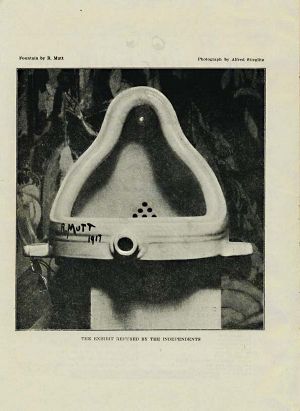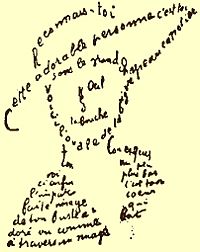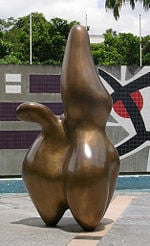Dada or Dadaism is a cultural movement that began in neutral ZĂŒrich, Switzerland, during World War I and peaked from 1916 to 1920. The movement primarily involved visual arts, literature (poetry, art manifestoes, art theory), theater, and graphic design, which concentrated its anti war politic through a rejection of the prevailing standards in art through anti-art cultural works.
Like Surrealism and many other modern art movements, Dadaism reflected the collapse of the cherished ideals of Western society. In the wake of the Industrial revolution, the "death of God," and the breakdown of pre-modern traditional society, the old verities no longer provided a stable basis for society. This had given rise to Modernism, and the rise of Progressivism, which held that society was evolving toward ever more perfect forms. This view was smashed by the catastrophe of the First World War. Dada represented a rebellion against that failure and all the established verities.
Overview
Dada activities included public gatherings, demonstrations, and publication of art/literary journals. Passionate coverage of art, politics, and culture filled their publications. The movement was a protest against the barbarism of World War I, the bourgeois interests that Dada adherents believed inspired the war, and what they believed was an oppressive intellectual rigidity in both art and everyday society. The movement influenced later styles, movements, and groups including surrealism, Pop Art and Fluxus. Dada was an international movement, and it is difficult to classify artists as being from any one particular country, as they were constantly moving from one place to another.
What is Dada?
According to its proponents, Dada was not art â it was "anti-art." Dada sought to fight art with art. For everything that art stood for, Dada was to represent the opposite. Where art was concerned with aesthetics, Dada ignored aesthetics. If art were to have at least an implicit or latent message, Dada strove to have no meaning â interpretation of Dada is dependent entirely on the viewer. If art is to appeal to sensibilities, Dada is to offend. It is perhaps then ironic that Dada became an influential movement in modern art. Dada became a commentary on order and the carnage they believed it wreaked. Through this rejection of traditional culture and aesthetics the artists associated with the movement hoped to destroy traditional culture and aesthetics.
According to Tristan Tzara, "God and my toothbrush are Dada, and New Yorkers can be Dada too, if they are not already." A reviewer from the American Art News stated that "The Dada philosophy is the sickest, most paralyzing and most destructive thing that has ever originated from the brain of man." Art historians have described Dada as originating, in large part, "in reaction to what many of these artists saw as nothing more than an insane spectacle of collective homicide."[1] Years later, Dada artists described the movement as "a phenomenon bursting forth in the midst of the postwar economic and moral crisis, a savior, a monster, which would lay waste to everything in its path. [It was] a systematic work of destruction and demoralization⊠In the end it became nothing but an act of sacrilege."[2] According to Dada, reason and logic had led people into the horrors of war; the only route to salvation was to reject logic and embrace anarchy and the irrational. However, this could also be thought of as the logical side of anarchy and rejection of values and order. It is not irrational to embrace the systematic destruction of values, if one thinks them to be flawed.
History
ZĂŒrich
In 1916, Hugo Ball, Emmy Hennings, Tristan Tzara, Hans Arp, Richard Huelsenbeck, Sophie TĂ€uber, along with others discussed art and put on performances in the Cabaret Voltaire (ZĂŒrich) expressing their disgust with the war and the interests that inspired it. By some accounts Dada coalesced on October 6 at the cabaret.
At the first public soiree at the cabaret on July 14, 1916, Ball recited the first manifesto (see text). Tzara, in 1918, wrote a Dada manifesto considered one of the most important of the Dada writings. Other manifestos followed.
Marcel Janco recalled,
- We had lost confidence in our culture. Everything had to be demolished. We would begin again after the "tabula rasa." At the Cabaret Voltaire we began by shocking common sense, public opinion, education, institutions, museums, good taste, in short, the whole prevailing order.
A single issue of Cabaret Voltaire was the first publication to come out of the movement.
After the cabaret closed down, activities moved to a new gallery, and Ball left Europe. Tzara began a relentless campaign to spread Dada ideas. He bombarded French and Italian artists and writers with letters, and soon emerged as the Dada leader and master strategist. (The Cabaret Voltaire is still in the same place at the Spiegelgasse 1 in the Niederdorf.)
ZĂŒrich Dada, with Tzara at the helm, published the art and literature review Dada beginning in July 1917, with five editions from ZĂŒrich and the final two from Paris.
When World War I ended in 1918, most of the ZĂŒrich Dadaists returned to their home countries, and some began Dada activities in other cities.
Origin of the word Dada
The origin of the name Dada is unclear; some believe that it is a nonsensical word. Others maintain that it originates from the Romanian artists Tristan Tzara and Marcel Janco's usage of the Romanian word for yes, which is often repeated several times for effect, thus resulting in da, da, meaning yes, yes. (Engl. equivalent: yeah, yeah as in speaking with sarcasm to say: yeah, right). Others believe that a group of artists assembled in ZĂŒrich in 1916, wanting a name for their new movement, chose it at random by stabbing a French-German dictionary with a paper knife, and picking the name that the point landed upon. Dada in French is a child's word for hobby-horse. In French the colloquialism, c'est mon dada, means it's my favorite, or it's my hobby.
It has also been suggested that the word "dada" was chosen randomly from the Larousse dictionary.
According to the Dada ideal, the movement would not be called Dadaism, much less designated an art-movement.
Berlin
The groups in Germany were not as strongly anti-art as other groups. Their activity and art was more political and social, with corrosive manifestos and propaganda, biting satire, large public demonstrations and overt political activities. It has been suggested that this is at least partially due to Berlin's proximity to the front, and that for an opposite effect, New York's geographic distance from the war spawned its more theoretically-driven, less political nature.
In February 1918, Richard Huelsenbeck gave his first Dada speech in Berlin, and produced a Dada manifesto later in the year. Hannah Höch and George Grosz used Dada to express post-World War I communist sympathies. Grosz, together with John Heartfield, developed the technique of photomontage during this period. The artists published a series of short-lived political journals, and held the International Dada Fair in 1920.
The Berlin group saw much in-fighting; Kurt Schwitters and others were excluded from the group. Schwitters moved to Hanover where he developed his individual type of Dada, which he dubbed Merz.
The Berlin group published periodicals such as Club Dada, Der Dada, Everyman His Own Football (Jedermann sein eigner Fussball), and Dada Almanach.
Cologne
In Cologne (Köln), Max Ernst, Johannes Theodor Baargeld and Arp launched a controversial Dada exhibition in 1920 which focused on nonsense and anti-bourgeois sentiments.
New York

Like ZĂŒrich, New York was a refuge for writers and artists from World War I. Soon after arriving from France, Marcel Duchamp and Francis Picabia met American artist Man Ray after arriving only days apart in June of 1915. By 1916 the three of them became the center of radical anti-art activities in the United States. American Beatrice Wood, who had been studying in France, soon joined them. Much of their activity centered in Alfred Stieglitz's gallery, 291, and the studio of Walter and Louise Arensberg. The New Yorkers did not label themselves Dada, nor did they issue manifestos or organize riotous events. However, they issued challenges to art and culture through publications such as The Blind Man, Rongwrong, and New York Dada in which they criticized the traditionalist basis for museum art. New York Dada lacked the disillusionment of European Dada and was instead driven by a sense of irony and humor.
During this time Duchamp began exhibiting readymades (found objects) such as a bottle rack, and got involved with the Society of Independent Artists. In 1917 he submitted his famous Fountain, a urinal signed R. Mutt, to the Society of Independent Artists showâonly to have the piece rejected. First an object of scorn within the arts community, it has since been canonized, ironically, and is often considered a watershed work of modern art. The committee presiding over Britain's prestigious Turner Prize in 2004, for example, called it "the most influential work of modern art." "Duchamp's urinal tops art survey"
Picabia's travels tied New York, ZĂŒrich and Paris groups together during the Dadaist period. For seven years he also published the Dada periodical 391 in Barcelona, New York City, ZĂŒrich, and Paris from 1917 through 1924.
By 1921, most of the original dada artists moved to Paris where Dada experienced its last major incarnation (see Neo-Dada for later activity).
Paris
The French avant-garde kept abreast of Dada activities in ZĂŒrich with regular communications from Tristan Tzara (whose pseudonym means "sad in country," a name chosen to protest the treatment of Jews in his native Romania), who exchanged letters, poems, and magazines with Guillaume Apollinaire, AndrĂ© Breton, Max Jacob, and other French writers, critics and artists.
Dada in Paris surged in 1920 when many of the originators converged there. Inspired by Tzara, Paris Dada soon issued manifestos, organized demonstrations, staged performances and produced a number of journals (the final two editions of Dada, Le Cannibale, and Littérature featured Dada in several editions.)
The first introduction of Dada artwork to the Parisian public was at the Salon des Indépendants in 1921. Jean Crotti exhibited works associated with Dada including a work entitled, Explicatif bearing the word Tabu.
The Netherlands
In The Netherlands the Dada movement centered mainly around Theo van Doesburg, most well-known for establishing the De Stijl movement and magazine of the same name. Van Doesburg mainly focused on poetry, and included poems from many well-known Dada writers in De Stijl such as Hugo Ball, Hans Arp and Kurt Schwitters. Van Doesburg became a friend of Schwitters, and together they organized the so-called Dutch Dada campaign in 1923, where Van Doesburg promoted a leaflet about Dada (entitled What is Dada?); Schwitters read his poems; Vilmos HuszĂ r demonstrated a mechanical dancing doll; and Van Doesburg's wife, Nelly, played avant-garde compositions on piano.
Van Doesburg wrote Dada poetry himself in De Stijl, although under a pseudonym, I.K. Bonset, which was only revealed after his tragic death in 1931. 'Together' with I.K. Bonset, he also published a short-lived Dutch Dada magazine called MĂ©cano.
Georgia
Although Dada itself was unknown in Georgia until at least 1920, from 1917-1921 a group of poets called themselves "41st Degree" (referring both to the latitude of Tbilisi, Georgia and to the temperature of a high fever) organized along Dadaist lines. The most important figure in this group was Iliazd, whose radical typographical designs visually echo the publications of the Dadaists. After his flight to Paris in 1921, he collaborated with Dadaists on publications and events.
Poetry, music and sound
Dada was not confined to the visual and literary arts; its influence reached into sound and music. Kurt Schwitters developed what he called sound poems and composers such as Erwin Schulhoff, Hans Heusser and Albert Savinio wrote Dada music, while members of Les Six collaborated with members of the Dada movement and had their works performed at Dada gatherings.
In the very first Dada Publication, Hugo Ball describes a "balalaika orchestra playing delightful folk-songs." African music and Jazz was common at dada gatherings, signaling a return to nature and naive primitivism.
Legacy
While broad, the movement was unstable. By 1924, Dada was melding into Surrealism, and artists had gone on to other ideas and movements, including socialist realism and other forms of modernism.
By the dawn of World War II, many of the European Dadaists had fled or emigrated to the United States. Some died in death camps under Hitler, who persecuted the kind of "Degenerate art" that Dada represented. The movement became less active as post-World War II optimism led to new movements in art and literature.
Dada was influential for various anti-art and political and cultural movements including Situationists.
At the same time that the ZĂŒrich Dadaists made noise and spectacle at the Cabaret Voltaire, Vladimir Lenin wrote his revolutionary plans for Russia in a nearby apartment. He was unappreciative of the artistic revolutionary activity near him. Tom Stoppard used this coincidence as a premise for his play Travesties (1974), which includes Tzara, Lenin, and James Joyce as characters.
The Cabaret Voltaire fell into disrepair until it was occupied by a group claiming to be neo-Dadaists, led by Mark Divo, from January to March of 2002. Many of their activities received as much public attention as the original Dada movement. The group included Jan Thieler, Ingo Giezendanner, Aiana Calugar, Lennie Lee and Dan Jones. After their eviction the space became a museum dedicated to the history of Dada. The work of Lennie Lee and Dan Jones remained on the walls of the museum.
Several notable retrospectives have examined the influence of Dada upon art and society. In 1967, a large Dada retrospective was held in Paris, France. In 2006, the Museum of Modern Art in New York City held a Dada exhibition in collaboration with the National Gallery of Art in Washington, D.C. and the Centre Pompidou in Paris.
Early practitioners
For a more complete list of Dadaists, see List of Dadaists.
- Guillaume Apollinaire - France
- Hans Arp - Switzerland, France and Germany
- Hugo Ball - Switzerland
- Johannes Baader - Germany
- John Heartfield - Germany
- Arthur Cravan - United States
- Jean Crotti - France
- Theo van Doesburg - The Netherlands
- Marcel Duchamp - France and United States
- George Grosz - Germany
- Max Ernst - Germany
- Elsa von Freytag-Loringhoven - United States, Germany
- Hannah Höch - Germany
- Raoul Hausmann - Germany
- Emmy Hennings - Switzerland
- Richard Huelsenbeck - Switzerland and Germany
- Marcel Iancu - Switzerland (born in Romania)
- Clement Pansaers - Belgium
- Francis Picabia - Switzerland, United States and France
- Man Ray - United States and France
- Hans Richter - Germany, Switzerland and United States
- Kurt Schwitters - Germany
- Sophie TĂ€uber - Switzerland
- Tristan Tzara - Switzerland and France (born in Romania)
- Beatrice Wood - United States and France
- Ilia Zdanevich (Iliazd) - Georgia and France
The word dada means grandfather in hindi/urdu.
See also
- Expressionism is seen as having its beginnings in Dada.
- Futurism positivistic predecessor to Dada.
- Modernism
- Surrealism, emerged from Dada.
Notes
ReferencesISBN links support NWE through referral fees
- Huelsenbeck, Richard. Memoirs of a Dada Drummer. University of California Press. ISBN 978-0520073708
- Kleiner, Fred S. and Mimiya, Christin J. Gardner's Art Through the Ages, 12th edition. Wadsworth Publishing, 2005. ISBN 0155050907
- Sandqvist, Tom. Dada East: The Romanians of Cabaret Voltaire. The MIT Press, 2006. ISBN 0262195070
External links
All links retrieved January 12, 2024.
- 391.org Contemporary Dada magazine and network continuing Francis Picabia's publication 391
- Dada Online
- Dada art (Dada Online) includes images showing the characteristics of Dada.
- The Essential DADA
| Western art movements |
| Renaissance · Mannerism · Baroque · Rococo · Neoclassicism · Romanticism · Realism · Pre-Raphaelite · Academic · Impressionism · Post-Impressionism |
| 20th century |
| Modernism · Cubism · Expressionism · Abstract expressionism · Abstract · Neue KĂŒnstlervereinigung MĂŒnchen · Der Blaue Reiter · Die BrĂŒcke · Dada · Fauvism · Art Nouveau · Bauhaus · De Stijl · Art Deco · Pop art · Futurism · Suprematism · Surrealism · Minimalism · Post-Modernism · Conceptual art |
Credits
New World Encyclopedia writers and editors rewrote and completed the Wikipedia article in accordance with New World Encyclopedia standards. This article abides by terms of the Creative Commons CC-by-sa 3.0 License (CC-by-sa), which may be used and disseminated with proper attribution. Credit is due under the terms of this license that can reference both the New World Encyclopedia contributors and the selfless volunteer contributors of the Wikimedia Foundation. To cite this article click here for a list of acceptable citing formats.The history of earlier contributions by wikipedians is accessible to researchers here:
The history of this article since it was imported to New World Encyclopedia:
Note: Some restrictions may apply to use of individual images which are separately licensed.

